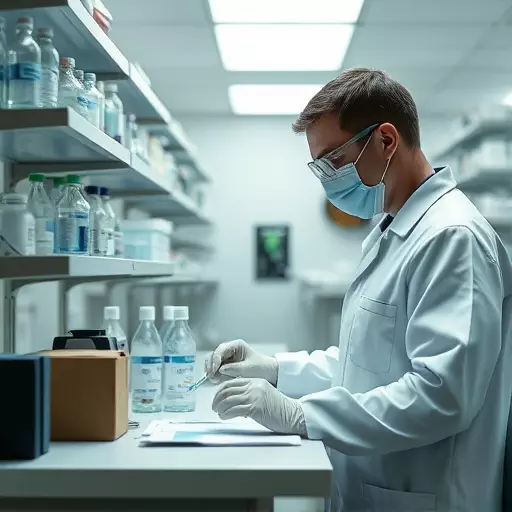In Ann Arbor, 3D printing technology is revolutionizing lab work, offering faster prototyping and precise designs. This innovation addresses concerns about automation-related job displacement while empowering smaller research institutions and startups through the growth of subscription-based diagnostic lab services. By automating tasks like equipment creation and reagent production, scientists can focus on complex research. This trend fosters a more inclusive scientific community, expedites experimentation, and ultimately accelerates discoveries across fields. Additionally, subscription-based diagnostic labs are transforming healthcare accessibility while mitigating job displacement by diversifying revenue streams. 3D printing's increasing demand is reshaping lab practices, making them more agile and responsive to researchers' needs.
The demand for 3D-printed lab equipment is skyrocketing, revolutionizing scientific research and development in Ann Arbor and beyond. This surge is driven by the rise of automated lab tasks, offering unprecedented efficiency but also addressing automation-related job displacement. Subscription-based diagnostic lab services are emerging as a new trend, enhancing healthcare accessibility. By exploring the cost-effective benefits and future implications of 3D-printed equipment, this article delves into how technology is reshaping laboratory practices, from cost savings to workforce adaptation.
- The Rise of 3D Printing in Scientific Research and Development
- Automating Lab Tasks: Benefits and Challenges for Workforce Displacement
- Subscription-Based Diagnostic Labs: A New Trend in Healthcare Accessibility
- 3D-Printed Equipment: Cost-Effective Solutions for Modern Laboratories
- Future Implications: How Technology is Shaping Laboratory Practices
The Rise of 3D Printing in Scientific Research and Development

The scientific research and development landscape in Ann Arbor and beyond is witnessing a significant shift with the rapid integration of 3D printing technology. This innovative approach to manufacturing has revolutionized lab work, offering scientists and researchers faster prototyping and the ability to create complex designs with precision. The rise of 3D printing in scientific circles addresses automation-related job displacement in labs by augmenting human labor rather than replacing it; it streamlines processes but still relies heavily on skilled professionals.
The growth of subscription-based diagnostic lab services has further fueled the demand for 3D-printed lab equipment. This trend empowers smaller research institutions and startups to access advanced manufacturing capabilities, fostering a more inclusive scientific community. By reducing the cost and time associated with traditional manufacturing methods, 3D printing allows for quicker iteration and experimentation, ultimately accelerating discoveries in various fields.
Automating Lab Tasks: Benefits and Challenges for Workforce Displacement

The integration of 3D printing technology into laboratory settings offers immense potential for streamlining tasks and improving efficiency in Ann Arbor’s thriving scientific community. One notable advantage lies in its ability to automate various lab procedures, from creating custom equipment and reagents to facilitating complex experimental set-ups. This automation can significantly reduce the time and manual effort required, enabling scientists to focus on more intricate research and analysis. As subscription-based diagnostic lab services grow in popularity, the demand for such advanced technologies is surging, promising a future where lab work becomes more precise and less labor-intensive.
However, addressing automation-related job displacement in labs presents a complex challenge. While 3D printing may increase productivity, it could potentially reduce the need for certain manual labor roles. The workforce may require adaptation as some tasks become automated, emphasizing the need for reskilling and upskilling initiatives to ensure scientists and lab technicians remain relevant in this evolving landscape. Balancing automation’s benefits with its impact on employment will be crucial for the future of laboratory work in Ann Arbor and beyond.
Subscription-Based Diagnostic Labs: A New Trend in Healthcare Accessibility

In recent years, a notable trend is emerging in healthcare—subscription-based diagnostic labs are gaining traction. This innovative model offers a new way to access lab work in Ann Arbor and beyond, potentially addressing automation-related job displacement in labs while revolutionizing healthcare accessibility. Instead of traditional one-time visits or extensive subscriptions for medical testing, these labs provide a flexible and cost-effective approach. Customers can opt into monthly or quarterly packages, allowing them to receive regular diagnostic services tailored to their needs.
The growth of subscription-based diagnostic lab services is driven by the demand for personalized healthcare and convenience. This model not only benefits individuals seeking routine monitoring but also offers advantages for preventive care and early disease detection. As the trend continues to grow, it could significantly impact the landscape of lab work in Ann Arbor, potentially leading to a more efficient and accessible healthcare system while mitigating some concerns related to automation-related job shifts.
3D-Printed Equipment: Cost-Effective Solutions for Modern Laboratories

In today’s digital era, the demand for efficient and cost-effective solutions in lab work in Ann Arbor is on the rise. 3D-printed equipment is revolutionizing modern laboratories by addressing automation-related job displacement while offering innovative ways to streamline processes. Traditional lab gear often involves high costs and lengthy lead times, but 3D printing enables rapid prototyping and customization at a fraction of the price, making it an attractive option for research institutions and diagnostic labs alike.
The growth of subscription-based diagnostic lab services further fuels the need for versatile and affordable tools. 3D-printed components can be designed to fit specific protocols and applications, enhancing flexibility and reducing waste. This technology empowers labs to adapt quickly to evolving needs, ensuring they remain competitive and efficient in an ever-changing landscape.
Future Implications: How Technology is Shaping Laboratory Practices

The future of laboratory practices is being reshaped by technological advancements, particularly in 3D printing. As the demand for 3D-printed lab equipment increases, labs across the country, including those in Ann Arbor, are embracing this innovative technology to streamline operations and enhance efficiency. This shift not only promises to address automation-related job displacement but also redefines the landscape of diagnostic services.
The growth of subscription-based diagnostic lab services further underscores this trend. 3D printing enables on-demand manufacturing of custom lab components, reducing waste and lowering costs. In light of these developments, labs are poised to become more agile and responsive to the evolving needs of researchers and healthcare professionals, ultimately driving progress in scientific discovery and patient care.
